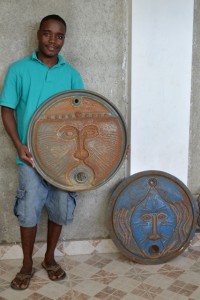A few months ago, I first heard of an author previously unknown to me by the name of Zora Neale Hurston. This was an egregious gap in my command of of American literature for she is recognized as woman of considerable note and stature in literary circles. Her crowning achievement, “Their Eyes Were Watching God” is a powerful story of a black woman living in the South in the 1930’s finding security, status, love, and finally herself. Hurston wrote this landmark piece while working on a Guggenheim grant she had received for the purpose of doing an anthropological survey in….are you ready for this?….Haiti.
So I gobbled up “Their Eyes Were Watching God,” which I would encourage anyone with the slightest bit of interest to read, for it truly is wonderful. Then I looked into her study of Haiti in the 1930’s. Hurston’s book, “Tell My Horse,” is a result of that effort. At once a diary, travelogue, political commentary, and ethnographic piece, she respectfully illuminates Haitian cultural life, with Voodoo at its center.
Actually, it is a book written in three parts, the first dealing with the blend of Africa and the New World in Jamaica, and if the opening page of the chapter entitled, ” Hunting the Wild Hog” is any indication it is not to be missed. To quote, “If you go to Jamaica, you are going to want to visit the Maroons at Accompong. I warn you in advance not to ride Col. Rowe’s wall-eyed, pot-bellied mule, which he sent to meet me at the end of the rail line so that I wouldn’t have to climb that last high peak on foot. That was very kind and I appreciated his hospitality, but the mule didn’t fall into that scheme somehow. The only thing that kept her from throwing me was that I fell off first. And the only thing that kept her from kicking me, biting me, and trampling me underfoot was the speed with which I got out of her way after the fall. Maybe it was that snappy orange four-in-hand tie that set her against me. I hate to think it was my face.” I have no line of defense against story-telling such as this. To me, it is marvelous.
The remaining two sections transport the reader to Haiti, first with a vivid and colorful foray into its history. Even though history “stops” in 1938, the year the book was written, it is amazing to me that it still so closely describes the Haiti of today. As she writes, “ The president of Haiti is really a king with a palace, with a reign limited to a term of years….There is no concept of the rule of the majority in Haiti. The majority, being unable to read or write, has no idea what is being done in their name.” Carrying on to the final section, the subject turns to Voodo and Voodoo gods, and it is here that Hurston truly shines. Her own immersion into Voodoo practice was as an initiate, not a mere adacemic observer. She describes Vodoo beliefs and rituals in a manner that is well-informed, respectful and endearing; veering at times to the romantic. She records legend and correlates it with ritual practice in a style that is at at the same time edifying and graceful.
So what more do you want? I’ve said it before and I’ll say it again: “Book club, anyone?”
Contributed by Linda for It’s Cactus


